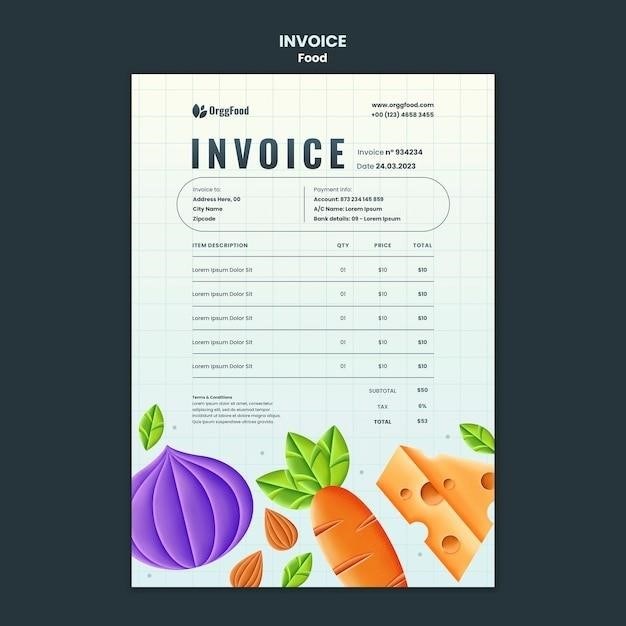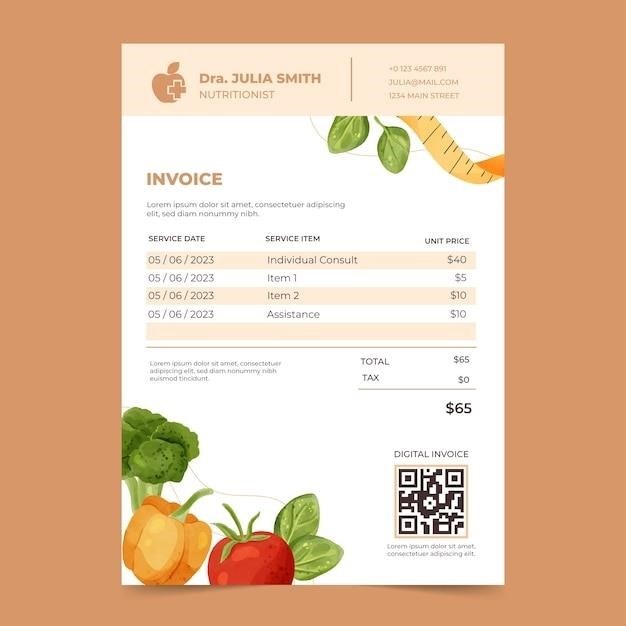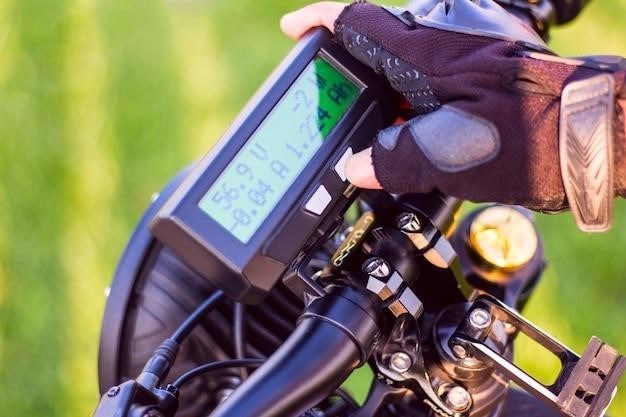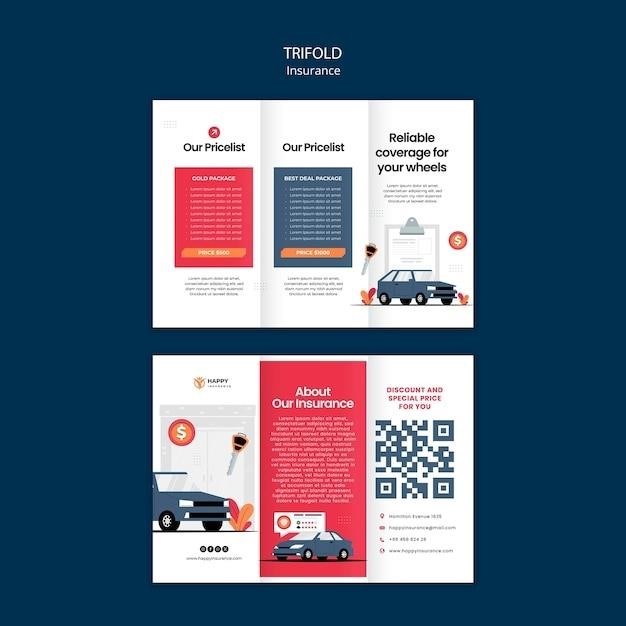
Food Temperature Record Sheet PDFs⁚ Essential for Food Safety
Food temperature record sheet PDFs are essential for ensuring food safety in any establishment that handles or serves food․ These sheets provide a structured way to track the temperature of food items, refrigerators, and freezers over time․ By recording these temperatures, businesses can identify potential hazards, implement corrective actions, and demonstrate compliance with food safety regulations․
Why Temperature Records Matter
Maintaining accurate food temperature records is crucial for ensuring food safety and preventing foodborne illnesses․ Temperature is a critical factor in controlling the growth of harmful bacteria that can cause food poisoning․ By monitoring and recording temperatures, businesses can identify potential hazards and take timely corrective actions to minimize risks․
Here’s why temperature records are so important⁚
- Preventing Foodborne Illness⁚ Bacteria thrive in the “danger zone” between 41°F and 135°F․ Regular temperature checks help ensure that food is kept below 41°F in refrigeration or above 135°F during hot holding, preventing bacterial growth․
- Compliance with Regulations⁚ Food safety regulations in most countries require businesses to maintain temperature records for specific food items and equipment․ This documentation demonstrates compliance and helps businesses avoid fines or legal issues;
- Identifying Potential Hazards⁚ Temperature records can reveal patterns or trends that indicate potential problems with equipment, storage practices, or food handling procedures․ This allows businesses to address issues before they lead to food spoilage or illness․
- Traceability and Accountability⁚ Temperature records provide a detailed history of food storage and preparation, making it easier to trace the source of any potential contamination․ This information is valuable for investigations and helps ensure accountability․
- Improving Food Safety Practices⁚ Regularly reviewing temperature records can help businesses identify areas for improvement in their food safety practices․ This could include optimizing equipment settings, refining storage procedures, or providing additional training to staff․
In summary, temperature records are essential for maintaining food safety, complying with regulations, identifying potential hazards, ensuring traceability, and improving overall food safety practices․
Types of Temperature Records
There are several types of temperature records that are commonly used in food safety management․ These records document the temperature of various food items, equipment, and processes, providing a comprehensive picture of food safety practices within an establishment․
- Refrigerator and Freezer Temperature Logs⁚ These records document the internal temperatures of refrigerators and freezers at regular intervals․ They are essential for ensuring that food is stored at the correct temperature to prevent bacterial growth․ This type of log is crucial for maintaining the safety of perishable items like meats, dairy products, and produce․
- Hot Holding Temperature Records⁚ These logs track the temperature of hot food items that are being held for service․ They ensure that hot food remains at a safe temperature above 135°F to prevent bacterial growth․ This is particularly important for foods like soups, stews, and casseroles that are kept hot for extended periods․
- Cooking Temperature Records⁚ These records document the internal temperatures of food items during the cooking process․ They ensure that food is cooked to the proper temperature to kill harmful bacteria․ This is especially important for meats, poultry, and seafood, which require specific internal temperatures for safe consumption․
- Cooling Temperature Records⁚ These records track the temperature of food items as they cool down after cooking․ They ensure that food is cooled rapidly to prevent bacterial growth․ Rapid cooling is critical for potentially hazardous foods like cooked meats, poultry, and soups․
- Delivery Temperature Records⁚ These records document the temperature of food items during transportation․ They ensure that food is kept at the correct temperature throughout the delivery process, preserving its safety and quality․ This is essential for ensuring that food arrives at its destination in a safe and edible condition․
The specific types of temperature records required will depend on the type of food establishment, the menu offered, and the local food safety regulations․
Regulations and Guidelines
Food temperature record sheets are not just a matter of good practice; they are often mandated by law․ Regulatory bodies worldwide have established strict guidelines regarding food storage, preparation, and serving temperatures to prevent foodborne illnesses․ These regulations are designed to protect public health and ensure the safety of food products․
In the United States, the Food and Drug Administration (FDA) and the United States Department of Agriculture (USDA) set forth regulations for food safety․ The FDA’s Food Safety Modernization Act (FSMA) emphasizes preventative measures, including proper temperature control․ The USDA’s Food Safety and Inspection Service (FSIS) sets standards for the handling and processing of meat, poultry, and egg products, including temperature requirements․
In the United Kingdom, the Food Standards Agency (FSA) is responsible for food safety and sets guidelines for food businesses․ The FSA emphasizes the importance of maintaining accurate temperature records and provides guidance on how to do so effectively․ Similar regulations and guidelines exist in other countries, highlighting the international importance of proper temperature control in food safety․
These regulations and guidelines often specify the minimum and maximum temperatures that food items must be kept at, the frequency of temperature checks, and the duration for which temperature records must be kept․ Failure to comply with these regulations can result in fines, penalties, or even closure of the food establishment․
Essential Information to Record
A comprehensive food temperature record sheet should capture essential information to ensure accurate tracking and analysis․ The specific details may vary depending on the type of food establishment, but generally include the following⁚
- Date and Time⁚ Record the date and time of each temperature measurement․ This helps establish a chronological timeline for monitoring changes in temperature;
- Location⁚ Specify the exact location of the temperature measurement․ This could be a refrigerator, freezer, bain-marie, or specific food item․
- Food Item⁚ Clearly identify the food item being monitored․ This could be a specific dish, ingredient, or food category (e․g․, raw meat, cooked vegetables)․
- Temperature Reading⁚ Record the actual temperature reading obtained using a calibrated thermometer․ Ensure that the units of measurement (Celsius or Fahrenheit) are clearly indicated․
- Comments/Actions: Include any relevant comments or actions taken in response to the temperature reading․ This could include notes on corrective actions, equipment adjustments, or any other relevant observations․
- Signature⁚ Require a signature from the individual who took the temperature reading and recorded the information․ This helps ensure accountability and traceability․
By meticulously recording this information, food businesses can create a detailed history of temperature readings, allowing for effective analysis and identification of any potential issues that require attention․
Templates and Downloads
Numerous food temperature record sheet templates are readily available online, offering a convenient starting point for businesses․ These templates are often downloadable as PDFs, providing a standardized format for recording temperature information․ Many resources offer free templates, while others may require a subscription or a small fee․
When searching for templates, consider the specific needs of your food establishment․ Some templates are designed for general use, while others cater to specific industries, such as restaurants, catering services, or retail food outlets․ Look for templates that provide sufficient space for recording all the essential information, including date, time, location, food item, temperature reading, and comments․
Downloading a pre-designed template can save time and effort in creating a custom record sheet․ However, it is crucial to review the template carefully and ensure it aligns with the specific requirements and regulations applicable to your food business․ You may need to modify the template to include additional fields or adjust the format to suit your specific needs․
Example Record Sheets
To gain a better understanding of the structure and content of a typical food temperature record sheet, it is helpful to examine some examples․ Many online resources provide sample record sheets that illustrate how different elements are organized and presented․ These examples can serve as a guide for creating your own record sheet or for evaluating the suitability of pre-designed templates․
A common format for a record sheet includes sections for recording the date, time, location of the food item, the name of the food item, the temperature reading, and any relevant comments․ Some examples may also include additional fields for recording the type of thermometer used, the person who took the measurement, and any corrective actions taken․
The specific information recorded on the sheet will vary depending on the type of food, the storage method, and the intended use․ For example, a record sheet for a refrigerator may include columns for recording the temperatures of different compartments, while a record sheet for hot food may focus on the temperature of the food itself․ By reviewing example record sheets, you can identify the essential information to include and adapt the format to your specific requirements․
Tips for Accurate Record Keeping
Maintaining accurate temperature records is crucial for ensuring food safety, but it requires more than just filling out a sheet․ Several tips can help you achieve consistency and reliability in your record keeping․
Firstly, using a calibrated thermometer is essential for obtaining accurate temperature readings․ Regular calibration ensures the thermometer provides precise measurements, preventing potential errors in your records․ Secondly, consistently using the same thermometer for all measurements helps maintain uniformity and reduces the risk of discrepancies․
Furthermore, ensuring the thermometer is properly inserted into the food item is crucial for obtaining a representative temperature reading․ For example, when checking the temperature of meat, the thermometer should be inserted into the thickest part to ensure the core temperature is accurately measured․ Proper handling and storage of the thermometer, as well as regular cleaning, help maintain its accuracy and prolong its lifespan․
Finally, recording the temperature readings promptly and accurately is essential․ Avoid relying on memory, as this can lead to errors․ Always write down the temperature reading immediately after taking it, and double-check the information before moving on to the next measurement․ By implementing these tips, you can ensure the accuracy and reliability of your temperature records, contributing to a safer food environment․

Benefits of Maintaining Temperature Records
The benefits of maintaining accurate food temperature records extend beyond simply complying with regulations․ They play a vital role in ensuring food safety, protecting consumers, and safeguarding the reputation of your establishment․
Firstly, temperature records provide a clear and documented history of food storage and handling practices․ This information is invaluable in case of a foodborne illness outbreak, allowing you to quickly identify potential sources of contamination and implement corrective measures․ Secondly, these records serve as evidence of your commitment to food safety, demonstrating to regulatory bodies and customers your adherence to best practices;
Moreover, regularly reviewing temperature records can help identify potential issues or trends․ For instance, if you notice consistent temperature fluctuations in a refrigerator, it may indicate a malfunctioning unit requiring immediate attention․ This proactive approach helps prevent food spoilage, reduces waste, and minimizes financial losses․ Finally, maintaining accurate records can contribute to improved employee training and awareness․ By analyzing the data, you can identify areas where staff may need additional training or support, fostering a culture of food safety within your establishment․
In conclusion, maintaining accurate food temperature records offers numerous benefits, including improved food safety, enhanced customer confidence, and a stronger reputation for your business․ By embracing this practice, you contribute to a safer food environment and demonstrate your commitment to providing high-quality products and services․
Software Solutions for Temperature Logging
In today’s digital age, there are numerous software solutions available to streamline and enhance temperature logging for food businesses․ These solutions offer a range of features designed to simplify record-keeping, improve accuracy, and provide valuable insights into food safety practices․
One significant advantage of software solutions is their ability to automate data collection․ Instead of manually recording temperatures on paper sheets, specialized software can integrate with temperature probes or sensors, automatically capturing and storing data at pre-determined intervals․ This eliminates the risk of human error and ensures that records are consistently accurate and up-to-date․
Moreover, software solutions often include features that simplify record-keeping and analysis․ They may provide customizable templates for different food types, storage units, or cooking processes․ This allows for efficient data organization and facilitates easy retrieval of specific records for audit purposes․ Some platforms even offer advanced analytics capabilities, generating reports that highlight trends, potential issues, and areas for improvement․
Ultimately, choosing the right software solution depends on your specific needs and budget․ However, the benefits of digital temperature logging are undeniable, offering greater efficiency, accuracy, and insights into food safety practices․ By embracing these technologies, food businesses can elevate their food safety standards, strengthen their compliance efforts, and protect the health of their customers․
Food Safety Checklists
Food safety checklists are essential tools for any establishment that handles or serves food․ They provide a structured framework for ensuring compliance with food safety regulations and best practices․ These checklists act as a guide, helping staff identify and address potential hazards at every stage of the food handling process, from receiving and storing ingredients to preparing and serving meals․
A comprehensive food safety checklist typically covers a wide range of areas, including⁚
- Personal Hygiene⁚ This section emphasizes the importance of handwashing, proper attire, and preventing cross-contamination․
- Food Storage and Handling⁚ Checklists address the safe storage of different food types, including temperature control, FIFO (First In, First Out) rotation, and preventing cross-contamination․
- Food Preparation⁚ This section emphasizes the importance of safe cooking temperatures, proper thawing techniques, and avoiding foodborne illness risks․
- Cleaning and Sanitization⁚ The checklist ensures that all equipment, surfaces, and utensils are thoroughly cleaned and sanitized to prevent bacterial growth․
- Pest Control⁚ This section focuses on measures to prevent pests from entering the food preparation area, as they can contaminate food and pose health risks․
Food safety checklists are not just a legal requirement; they are a crucial component of a proactive food safety program․ By using checklists regularly, businesses can ensure that staff are trained, aware of potential hazards, and consistently following safe practices․ This leads to a safer environment for both employees and customers, enhancing the reputation and success of the establishment․
Resources and Further Information
For those seeking comprehensive information on food safety, a wealth of resources and guidance is readily available online and through various government agencies․ These resources can provide valuable insights into the importance of temperature control, proper food handling techniques, and the legal requirements surrounding food safety․
The Food Standards Agency (FSA) in the UK offers a wealth of information on food safety, including comprehensive guidelines on temperature recording, food storage, and handling practices․ Their website provides downloadable resources, including temperature log sheets, and offers guidance on how to implement effective food safety procedures․ Similarly, the Food and Drug Administration (FDA) in the United States offers a vast library of information on food safety, including regulations, guidelines, and educational materials․
Several other reputable organizations dedicated to food safety provide valuable resources and guidance․ The National Restaurant Association (NRA) offers comprehensive training programs and resources for food service establishments․ The National Association of Food Equipment Manufacturers (NAFEM) focuses on food safety practices related to equipment and provides educational materials for both professionals and consumers․
By accessing these resources, individuals and businesses can stay informed about the latest food safety practices, access valuable tools and templates, and ensure compliance with all relevant regulations․




